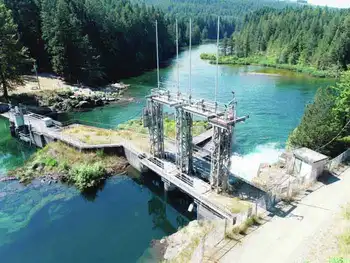Nuclear power pushed for oil sands production
OTTAWA, ONTARIO - The much-touted potential for Canada's oil sands to offset projected declines in North American oil production remains highly questionable because of constraints on natural gas production and environmental problems, a group of Swedish industry experts concludes in a new report.
To meet its ambitious targets, the industry would likely require the construction of a nuclear power plant near Fort McMurray in Alberta in order to replace natural gas in the energy-intensive production process, the scientists argue.
Writing in the influential European journal Energy Policy recently, the analysts for the Uppsala Hydrocarbon Depletion Study Group warned that the world should not count on Canada's massive oil sands deposits to meet future demand growth.
"While the theoretical future oil supply from the oil sands is huge, the potential ability for the Canadian oil sands industry to meet expectations of bridging a future oil supply gap is not based on reality," said the authors, who are led by prominent "peak oil" theorist Kjell Aleklett, a physicist from the University of Uppsala.
In a speech to a high-powered business audience in New York last week, Prime Minister Stephen Harper said production from the oil sands - which now supply about one million barrels of crude a day - is now "on its way" to four million barrels by 2015, a target that exceeds the bullish 3.5 million barrels forecast used by the Canadian Association of Petroleum Producers.
In a telephone interview, Mr. Aleklett said the industry is counting on plentiful, reasonably priced supplies of natural gas to keep their billion-dollar plants commercially viable. He argued natural gas production would be constrained in the coming years, and oil sands users will have to compete with growing demand from traditional users in the U.S. and Canada. As a result, prices are expected to climb substantially.
"The gas situation in North America is terrible," Mr. Aleklett said. "It's unbelievable what they are doing and what they are saying (about future gas production), maybe they are afraid to tell the reality because it is just so grim."
Natural gas prices have fallen sharply this year from record levels touched in 2005, as companies cranked up production while demand failed to keep pace. But Mr. Aleklett said conventional natural production in Western Canada is projected to decline sharply and new unconventional sources remain uncertain and expensive.
Oil and gas companies have already announced plans to spend about $60-billion to build oil sands plants that would produce an additional 2.5 million barrels of oil a day by 2015. The projects include surface mining operations and the underground, in situ type, where steam is injected to remove the heavy crude trapped in the sands.
Mr. Aleklett said the aggressive forecasts of oil sands production fail to take into account constraints, from limits to natural gas production and from environmental considerations. He added he had not even factored in labour shortages and other construction risks, which some industry players are warning will slow the development. One alternative, he said, would be a nuclear power plant - or a series of smaller ones - to replace natural gas. However, he said building a nuclear plant would be a "complicated matter."
"The development of this energy source has obvious social and economic constraints," he and his co-authors wrote. "It will take at least seven years to implement a full-scale expansion program of nuclear plants for oil sands industrial use.
Greg Stringham, vice-president of the Canadian Association of Petroleum Producers, said domestic and French companies have visited the oil patch to promote the nuclear option. But he said the companies have yet to come up with a viable approach.
Mr. Stringham acknowledged the oil sands firms are concerned about the rising price - though less the actual availability - of natural gas. And they are finding ways to reduce per-barrel consumption, and in some cases, eliminate it altogether.
Oil sands producers are clearly concerned about natural gas prices and are experimenting with a range of alternatives that would reduce or eliminate the need for gas.
At its Whitesands in situ project, Petrobank and its partners are working on a plan to burn residual bitumen underground in order to loosen and recover the commercially available crude. That process would leave the carbon dioxide created from the burn trapped underground.
Several companies are also planning to burn asphalt-like bitumen to produce electricity and steam above ground.
Related News

Drought, lack of rain means BC Hydro must adapt power generation
VANCOUVER - BC Hydro is adjusting its operating plans around power generation as extended heat and little forecast rain continue to impact the province, a report says.
“Unpredictable weather patterns related to climate change are expected to continue in the years ahead and BC Hydro is constantly adapting to these evolving conditions,” said the report, titled “Casting drought: How climate change is contributing to uncertain weather and how BC Hydro’s generation system is adapting.”
The study said there is no concern with BC Hydro being able to continue to deliver power through the drought because there is enough water at its larger…




